
|
| |
|
|
|
|
 |
|
|
SS-Panzer divisions in Normandy
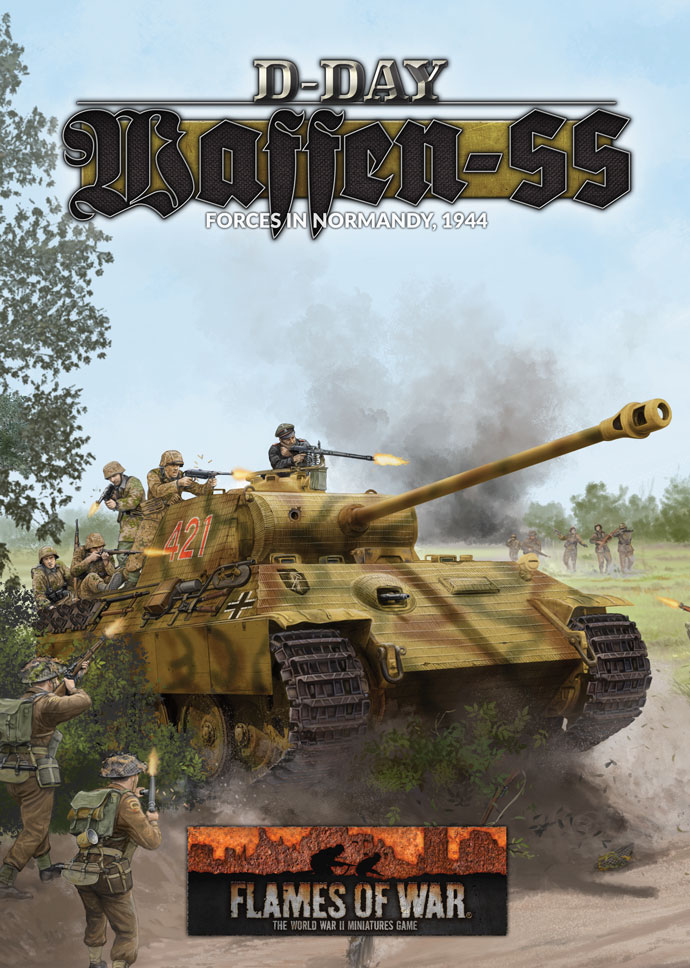 |
SS-Panzer divisions in Normandy
The 1. SS, 9. SS, and 10. SS-Panzer Divisions feature in the D-Day: Waffen-SS book. We take a brief look at their roles in the Normandy Campaign.
The 17. SS-Panzergrenadierdivision also took part in the defence of Normandy, which is covered in a separate article.
17. SS-Panzergrenadierdivision...
We hope to be adding more details the 2. SS-Panzerdivision Das Reich and 12. SS-Panzerdivision Hitlerjugend in the future.
|
9. SS-Panzerdivision ‘Hohenstaufen’
The 9. SS-Panzerdivision ‘Hohenstaufen’ was formed, along with the 10. SS-Panzerdivision ‘Frundsberg’, in February 1943 in France. The division was formed mainly from conscripts transferred from the Reichsarbeitdienst (RAD), a labour organisation to prepare youth for military service. Initially the division was formed as a Panzergrenadier formation, but in October 1943 it was decided to make it a full Panzerdivision.
The division’s title was in honour of the Hohenstaufen dynasty that had ruled as kings and Holy Roman Emperors during the 12th and 13th centuries, in particular Friedrich II (1194-1250). |
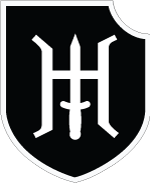 |
| They first went into action in March 1944 when they were sent to the Ukraine to help in the relief of Generaloberst Hube’s 1. Panzeramee that had become encircled near Kamenets Podolsky. The 9. SS-Panzerdivision ‘Hohenstaufen’, along with the 10. SS-Panzerdivision ‘Frundsberg’, were form into the II. SS-Panzerkorps. They were then sent to attack the town of Tarnopol. The heavy mud conditions of the spring thaw slowed progress, but the divisions was finally able to link up with Hube’s forces at the town of Buczacz. |
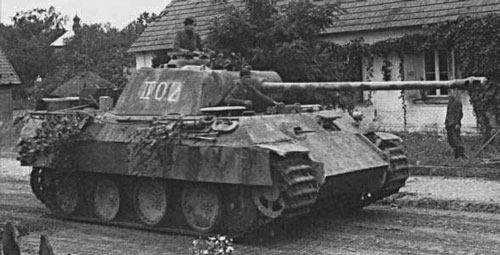 |
During the relief of the 1. Panzerarmee the 9. SS-Panzerdivision had suffered heavy casualties and in April 1944 were pulled out of the line for refitting. The II. SS-Panzerkorps then spent up until June acting as the reserve of Heersgruppe Nordukraine, fighting many ‘fire brigade’ actions until the Normandy Invasion called the Korps back to France on 12 June.
9. SS-Panzerdivision ‘Hohenstaufen’ and its sister division continued to fight side-by-side in Normandy.
|
They next took up positions opposing the British and Canadian forces attacking Caen in eastern Normandy. They did this not without suffering casualties from Allied fighter-bombers during the march to the front. In early July they were once again in the thick of the fighting. After repelling the British attacks they were pulled out of the line on 10 July to go into reserve.
They were quickly back in action defending Hill 112 during the next British offensive (Operation Jupiter) relieving their battered brothers of the 10. SS-Panzerdivision ‘Frundsberg’. They held off determined attacks by British forces until they were once again relieved before being thrown once more into action against the British armoured thrust of Operation Goodwood. They held their position, but suffered heavy casualties as a consequence. |
|
They were next in action delaying the Canadians during Operation Totalize. They succeeded in conduction a fighting withdrawal, avoided entrapment at Falaise and fought to keep the escape route from the pocket open.
By late August the German were in full retreat from Normandy and France. The division was involved in several rearguard actions through France and Belgium until they were finally pulled out of the line for a refit in September 1944. During the Normandy campaign and subsequent withdrawal they had lost over half their number in casualties (15,900 in June to about 7,000 in September).
19. SS-Panzergrenadier-Regiment
20. SS-Panzergrenadier-Regiment
9. SS-Panzer-Regiment
9. SS-Aufklärung-Abteilung
9. SS-Panzerjäger-Abteilung
9. SS-FlaK-Abteilung
9. Pioneer-Abteilung
9. SS-Panzerartillerie-Regiment
|
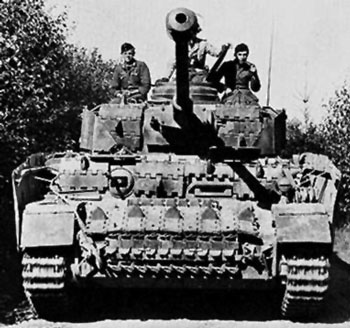 |
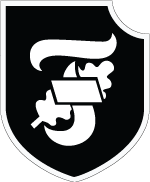 |
10. SS-Panzerdivision ‘Frundsberg’
Like the 9. SS-Panzerdivision ‘Hohenstaufen’, the 10. SS-Panzerdivision ‘Frundsberg’ was formed mainly from Reichsarbeitdienst (RAD) conscripts. Initially the division was to be titled ‘Karl der Große’ (Charlemagne), but as the French volunteer 33. Waffen-Grenadierdivision der SS has already selected this title it was changed to ‘Frundsberg’ after a 16th century landsknecht commander Georg von Frundsberg.
The division went with the 9. SS-Panzerdivision ‘Hohenstaufen’ to the eastern front to take part in relief of the 1. Panzerarmee as part of the II. SS-Panzerkorps in the Ukraine. It fought alongside its sister division for its time in the east before also being transferred back to France to face the Allied invasion.
|
|
Like the 9. SS-Panzer, the 10. SS-Panzerdivision spent its time in Normandy facing the British sector around the city of Caen. They were immediately thrust into action against Operation Epsom. Counterattacks on the flanks of the British thrust by the 9. SS-Panzer and 10. SS-Panzer divisions finally forced the 11th Armoured Division fighting for Hill 112 to withdraw on 1 July.
The 10. SS-Panzerdivision ‘Frundsberg’ remained in position on Hill 112 until relieved by the 9. SS-Panzerdivision ‘Hohenstaufen’.
In late July the II. SS-Panzerkorps was forced to swing west to face the British attacking the towards Vire and Mont Pinçon during Operation Bluecoat. On 2 August the division was redeployed against the British VIII Corps, halting their advance 3 kilometres from Vire. By mid August the division was holding off the US XV Corps at Domfront.
|
|
Along with other German divisions the ‘Frundsberg’ had withdrawn towards Falaise by 16 August and had begun to cross the Orne River.
On 22 August Army Group B reported that the division has no tanks left and only four battalions of infantry. The remnants of the division were withdrawn from the line and sent to Holland for rest and refit.
21. SS-Panzergrenadier-Regiment
22. SS-Panzergrenadier-Regiment
10. SS-Panzer-Regiment
10. SS-Aufklärung-Abteilung
10. SS-Panzerjäger-Abteilung
10. SS-FlaK-Abteilung
10. Pioneer-Abteilung
10. SS-Panzerartillerie-Regiment
|
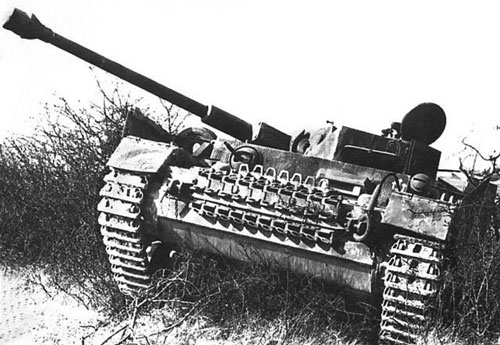 |
1. SS-Panzerdivision Leibstandarte SS
‘Adolf Hitler’
Leibstandarte SS ‘Adolf Hitler’ started its military carrier as an infantry regiment attached to the 17. Infanteriedivision during the invasion of Poland. I was converted into a brigade in 1941 and finally a full division in just before Operation Barbarossa. After many hard battles on the eastern front it was transferred to France in July 1942 to refit as a Panzergrenadierdivision (though with a full regiment of Panzers they were a Panzerdivision is all but name) before returning once more to the east in January 1943. |
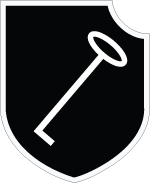 |
After fighting in the epic struggles at Kharhov and Kursk the division was transferred to Italy in August 1943. During their time in Italy they were involved in anti-partisan operations and the disarming of the Italian armed forces after the Italian surrender to the Allies. During this time they finally began to reorganise as a full Panzerdivision.
They were soon shifted back to the east where they took part in operations at Kotscherovo, Cherkassy, and the relief of the Korsun Pocket. |
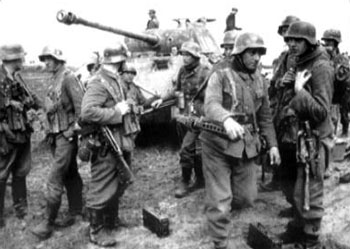 |
In March the majority of the Leibstandarte was withdrawn to Belgium for rest and refit, however one Kampfgruppe was left behind. On 22 March, the entire 1.Panzer-Armee was encircled in the Kamenets-Podolsky Pocket. The Leibstandarte Kampfgruppe took part in the desperate fighting to escape the encirclement, forming a part of the spearhead that linked up with the II.SS-Panzerkorps near Buczacz on 6 April 1944. In April the shattered remnants of the Kampfgruppe were ordered to Belgium to join the rest of the division
The 1. SS-Panzerdivision Leibstandarte SS ‘Adolf Hitler’ joined the battle for Normandy in July when elements of it were sent to help oppose Operation Goodwood. |
| Near Garcelles, near Caen, the I. Battalion, 1. SS-Panzer-Regiment counterattacked with its Panthers the 29th Tank Brigade of the British 11th Armoured Division.The rest of the division, apart from those left in Belgium, was waiting in reserve in Falaise and were quickly rushed to the front to confront the British assault. They and the 21. Panzerdivision immediately counterattacked and halted the British advance and forcing the British to withdraw. The operation had cost the British 126 destroyed tanks. |
The Leibstandarte was next in action defending the ridge at Bourguebus on 19 July once again with their Panthers. The Leibstandarte held until their right was relieved by the timely arrival of units of the 12. SS-Panzerdivision ‘Hitlerjugend’.
The Leibstandarte was involved in the counterattack to cut off the American breakout in August (Operation Luttich). The attack was launched on 7 August. However, after making initial gains the Allied Aircraft made it almost impossible to make substantial gains. They 1. SS-Panzer-Regiment, two battalions of SS-Panzergrenadiers, a Panzerpionierkompanie and the Flak-Abteilung took part in the failed operation. |
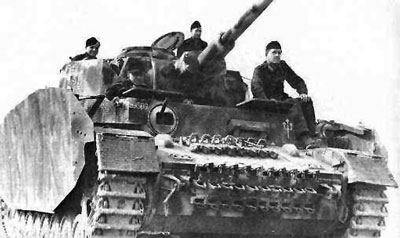 |
| The Leibstandarte withdrew towards Falaise. The division had been reduced to several small Kampfgruppen. They continued to fight hard and launched a breakout of Falaise on 22 August and escaped with two Kampfgruppen, but no panzers or artillery pieces were left. In September they continued their fighting withdrawal into German. |
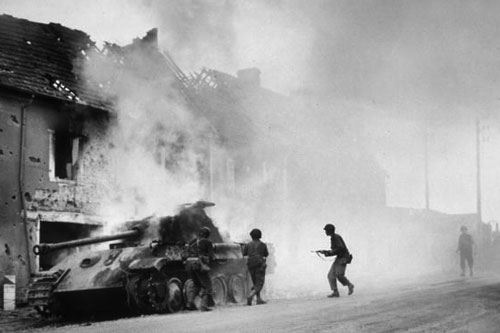 |
1. SS-Panzergrenadier-Regiment
2. SS-Panzergrenadier-Regiment
1. SS-Panzer-Regiment
1. SS-Sturmgeschutz-Abteiling
1. SS-Aufklärung-Abteilung
(1. Panzerspähkompanie remained in Belgium)
1. SS-Panzerjäger-Abteilung
1. SS-FlaK-Abteilung (3.7cm armed
5. Kompanie remained in Belgium)
1. Pioneer-Abteilung
1. SS-Panzerartillerie-Regiment (III. Battalion remained in Belgium)
1. SS-Werfer-Abteilung (remained in Belgium) |
Last Updated On Thursday, July 9, 2020 by Wayne at Battlefront
|
|
|